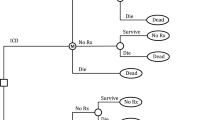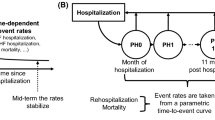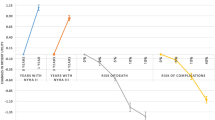Abstract
Medical decision making can be challenging due to the trade-off between improving clinical efficacy and the associated medical costs. Evaluation of the incremental cost-effectiveness ratio (ICER) of different treatment programs is important for cost-effectiveness analysis. Individualized treatment regimes (ITRs) that consider patient heterogeneity can lead to varying health benefits and costs. To identify a promising ITR that balances efficacy and cost, the ICER criterion can be used to evaluate the quality of the ITR. We propose a method that considers both health benefits and costs to derive the the optimal ITR. We utilize Dinkelbach’s algorithm to transform a fractional program into a parametric program, which is easier to handle. We compare our method to ITRs that only optimize a single outcome (benefits or costs) through extensive simulation studies and show that our approach performs satisfactorily. To demonstrate the practical application of our method, we apply it to the Multicenter Automatic Defibrillator Implantation Trial with Cardiac Resynchronization Therapy (MADIT-CRT) study, a randomized trial. Our approach can help identify an optimal ITR that balances the trade-off between clinical efficacy and medical costs. Overall, our method provides a valuable tool for medical decision making that takes into account patient heterogeneity and cost-effectiveness analysis.

Similar content being viewed by others
References
Qian M, Murphy SA (2011) Performance guarantees for individualized treatment rules. Ann Stat 39(2):1180
Zhao Y, Zeng D, Rush AJ, Kosorok MR (2012) Estimating individualized treatment rules using outcome weighted learning. J Am Stat Assoc 107(499):1106–1118
Zhou X, Mayer-Hamblett N, Khan U, Kosorok MR (2017) Residual weighted learning for estimating individualized treatment rules. J Am Stat Assoc 112(517):169–187
Houede N, Thall PF, Nguyen H, Paoletti X, Kramar A (2010) Utility-based optimization of combination therapy using ordinal toxicity and efficacy in phase i/ii trials. Biometrics 66(2):532–540
Huang X, Xu J (2020) Estimating individualized treatment rules with risk constraint. Biometrics. https://doi.org/10.1111/biom.13232
Lee J, Thall PF, Ji Y, Müller P (2015) Bayesian dose-finding in two treatment cycles based on the joint utility of efficacy and toxicity. J Am Stat Assoc 110(510):711–722
Luckett DJ, Laber EB, Kosorok MR (2017) Estimation and optimization of composite outcomes. ar**v preprint ar**v:1711.10581
Thall PF (2012) Bayesian adaptive dose-finding based on efficacy and toxicity. J Stat Res 46(2):187–202
Lizotte DJ, Bowling M, Murphy SA (2012) Linear fitted-q iteration with multiple reward functions. J Mach Learn Res 13(1):3253–3295
Laber EB, Lizotte DJ, Ferguson B (2014) Set-valued dynamic treatment regimes for competing outcomes. Biometrics 70(1):53–61
Wang Y, Fu H, Zeng D (2018) Learning optimal personalized treatment rules in consideration of benefit and risk: with an application to treating type 2 diabetes patients with insulin therapies. J Am Stat Assoc 113(521):1–13
Xu Y, Greene TH, Bress AP, Sauer BC, Bellows BK, Zhang Y, Weintraub WS, Moran AE, Shen J (2020) Estimating the optimal individualized treatment rule from a cost-effectiveness perspective. Biometrics. https://doi.org/10.1111/biom.13406
Mushlin AI, Hall WJ, Zwanziger J, Gajary E, Andrews M, Marron R, Zou KH, Moss AJ (1998) The cost-effectiveness of automatic implantable cardiac defibrillators: results from madit. Circulation 97(21):2129–2135
Wailoo AJ, Bansback N, Brennan A, Michaud K, Nixon RM, Wolfe F (2008) Biologic drugs for rheumatoid arthritis in the medicare program: a cost-effectiveness analysis. Arthr Rheum 58(4):939–946
McIntosh E, Barlow J, Davis H, Stewart-Brown S (2009) Economic evaluation of an intensive home visiting programme for vulnerable families: a cost-effectiveness analysis of a public health intervention. J Pub Health 31(3):423–433
Jiang G, Wu J, Williams GR (2000) Fieller’s interval and the bootstrap-fieller interval for the incremental cost-effectiveness ratio. Health Serv Outcomes Res Methodol 1(3–4):291
O’Brien BJ, Briggs AH (2002) Analysis of uncertainty in health care cost-effectiveness studies: an introduction to statistical issues and methods. Stat Methods Med Res 11(6):455–468
Chen S, Zhao H (2013) Estimating incremental cost-effectiveness ratios and their confidence intervals with different terminating events for survival time and costs. Biostatistics 14(3):422–432
Dinkelbach W (1967) On nonlinear fractional programming. Manage Sci 13(7):492–498
Rubin DB (1974) Estimating causal effects of treatments in randomized and nonrandomized studies. J Educ Psychol 66(5):688
Schulte PJ, Tsiatis AA, Laber EB, Davidian M (2014) Q-and a-learning methods for estimating optimal dynamic treatment regimes. Stat Sci: Rev J Inst Math Stat 29(4):640
Liu Y, Wang Y, Kosorok MR, Zhao Y, Zeng D (2018) Augmented outcome-weighted learning for estimating optimal dynamic treatment regimens. Stat Med 37(26):3776–3788
Bang H, Tsiatis AA (2000) Estimating medical costs with censored data. Biometrika 87(2):329–343
Zhao H, Zuo C, Chen S, Bang H (2012) Nonparametric inference for median costs with censored data. Biometrics 68(3):717–725
Noyes K, Veazie P, Hall WJ, Zhao H, Buttaccio A, Thevenet-Morrison K, Moss AJ (2013) Cost effectiveness of cardiac resynchronization for the prevention of heart failure. J Cardiovasc Electrophysiol 24(1):66
Martí R, Resende MG, Ribeiro CC (2013) Multi-start methods for combinatorial optimization. Eur J Oper Res 226(1):1–8
Laber EB, Zhao Y-Q (2015) Tree-based methods for individualized treatment regimes. Biometrika 102(3):501–514
Mi X, Zou F, Zhu R (2019) Bagging and deep learning in optimal individualized treatment rules. Biometrics 75(2):674–684
Murphy SA (2003) Optimal dynamic treatment regimes. J Royal Stat Soc B 65:331–366
Zhao Y-Q, Zeng D, Laber EB, Kosorok MR (2015) New statistical learning methods for estimating optimal dynamic treatment regimes. J Am Stat Assoc 110(510):583–598
Author information
Authors and Affiliations
Corresponding author
Appendices
Appendix A Proof
1.1 Proof of Proposition 2.1
Proof
We first note that (3) is equivalent to \(\underset{d \in D }{\max }\ \quad \{E^d(T) - T_0\}/\{E^d(max(R, R_0)) - R_0\}\), given the maximizer of (3) must be in the set D. Given any fixed \(d \in D\), we have
Thus, \(\underset{d\in D}{\max }\ \{E^d(T) - T_0\}/\{E^d(max(R, R_0)) - R_0\}\) is equivalent to minimizing its inverse, which is \(\underset{d\in D}{\min }\{E^d(max(R, R_0)) - R_0\} /\{E^d(T) - T_0\}\). The proof of the equivalence between (4) and (??) is similar, after observing \(\underset{\theta \in \Theta }{\min } E^d(\max (R, \theta ))=E^d(max(R, -\infty ))=E^d(R), \forall d\in D\). \(\square\)
1.2 Proof of Theorem 2.2
The proof of Theorem 2.2 directly follows from that of [19]. We define \(N(d)= E^{d}(T)-T_0\), and \(D(d)= E^{d}(\textbf{R})-R_0\). Our proposed objective can be formulated as
We consider another related problem
where \(q\in \mathbb {R}\). We would want to prove \(q^*=\frac{N(d^*)}{D(d^*)}=\underset{d \in {S}}{\max } \quad \frac{N(d)}{D(d)}\) iff \(F(q^*)=\underset{d \in {S}}{\max } \quad \{N(d)- q^*D(d)\}=0\).
Proof
We first establish lemmas regarding \(F(q)=\underset{d \in {S}}{\max } \quad \{N(d)- qD(d)\}\).
-
1.
F(q) is convex over \(\mathbb {R}\).
-
2.
F(q) is continuous for \(q \in \mathbb {R}\).
-
3.
F(q) is strictly monotonic decreasing function of q.
The proofs of lemmas are detailed in [19]. We can then prove \(F(q) = 0\) has an unique solution, say \(q^*\). This assertion results from (2), (3), and the following fact \(\lim _{q\rightarrow -\infty } F(q)=+\infty\), and \(\lim _{q\rightarrow \infty } F(q)=-\infty\).
\(\boxed {\hbox {Part 1}}\) In part 1, we prove if \(q^*=\frac{N(d^*)}{D(d^*)}=\underset{d \in {S}}{\max } \quad \frac{N(d)}{D(d)}\), then \(F(q^*)=\underset{d \in {S}}{\max } \quad \{N(d)- q^*D(d)\}=0\). We let \(d^*\) to be solution to (1). We then have \(N(d^*)/D(d^*)=q^*\ge {N(d)}/{D(d)}, \forall d\in S\). Given \(D(d)>0, \forall d\in S\), we have
From (3) we see that \(F(q^*)=\underset{d \in {S}}{\max } \quad \{N(d)- q^*D(d)\}=0\), and \(d^*\) is an maximizer of \(\underset{d \in {S}}{\max } \quad \{N(d)- q^*D(d)\}\).
\(\boxed {\hbox {Part 2}}\) In part 2, we prove if \(F(q^*)=\underset{d \in {S}}{\max } \quad \{N(d)- q^*D(d)\}=0\), then \(q^*=\frac{N(d^*)}{D(d^*)}=\underset{d \in {S}}{\max } \quad \frac{N(d)}{D(d)}\). We let \(d^*\) to be a solution to (2) such that \(N(d^*)- q^*D(d^*)=0\). The definition of (2) implies that \(N(d)- q^*D(d)\le N(d^*)- q^*D(d^*)=0, \forall d\in S\). Therefore, we have
From (4) we have \(q^*\ge N(d)/D(d),\forall d\in S\), that is \(q^*\) is the maximum of problem (3). Given that \(N(d^*)/D(d^*) =q^*\), we can conclude \(d^*\) is a solution for (1). Therefore, \(d^*\) that solves (2), with \(q=q^*\), also solves (1). \(\square\)
The above theorem does not guarantee the uniqueness of \(d^*\). While the strict conditions of N(d) and D(d) being continuous and S being compact may not always hold, we find practical success in solving a sequence of convex problems \(\underset{d \in {S}}{\max } \quad {N(d)- qD(d)}\) indexed by q, leading to convergence.
Appendix 2
1.1 Additional Simulation Results Under Small Sample Size (See Table 6)
Rights and permissions
Springer Nature or its licensor (e.g. a society or other partner) holds exclusive rights to this article under a publishing agreement with the author(s) or other rightsholder(s); author self-archiving of the accepted manuscript version of this article is solely governed by the terms of such publishing agreement and applicable law.
About this article
Cite this article
Dong, X., Zhao, YQ. Estimating Individualized Treatment Regimes to Optimize Incremental Cost-Effectiveness Ratio. Stat Biosci (2024). https://doi.org/10.1007/s12561-024-09440-x
Received:
Revised:
Accepted:
Published:
DOI: https://doi.org/10.1007/s12561-024-09440-x




